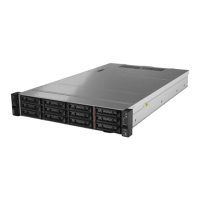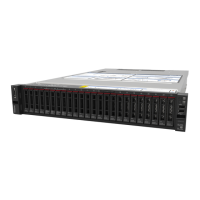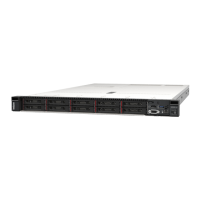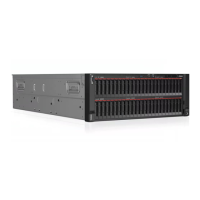Table 1. Server specifications (continued)
Acoustical noise emissions
• Sound power levels, idle
– 5.0 bels, minimum
– 5.3 bels, typical
– 6.5 bels, maximum
• Sound power levels, operating
– 5.3 bels, minimum
– 6.1 bels, typical
– 7.0 bels, maximum
Notes:
• These sound power levels are measured in controlled acoustical environments
according to procedures specified by ISO 7779 and are reported in accordance
with ISO 9296.
• The declared acoustic noise levels are based on specified configurations and they
may change depending on configurations/conditions.
• The declared acoustic noise levels may increase greatly, if high-power
components are installed, for example, some high-power NICs, CPUs, and GPUs.
Environment The server is supported in the following environment:
Note: This server is designed for standard data center environment and
recommended to be placed in industrial data center.
• Air temperature:
– Operating:
– ASHRAE class A2: 10–35°C (50–95°F); when the altitude exceeds 900 m
(2953 ft), the maximum ambient temperature value decreases by 1°C (1.8°F)
with every 300 m (984 ft) of altitude increase.
– ASHRAE class A3: 5–40°C (41–104°F); when the altitude exceeds 900 m
(2953 ft), the maximum ambient temperature value decreases by 1°C (1.8°F)
with every 175 m (574 ft) of altitude increase.
– ASHRAE class A4: 5–45°C (41–113°F); when the altitude exceeds 900 m
(2953 ft), the maximum ambient temperature value decreases by 1°C (1.8°F)
with every 125 m (410 ft) of altitude increase.
– Server off: 5–45°C (41–113°F)
– Shipping or storage: -40–60°C (-40–140°F)
• Maximum altitude: 3050 m (10 000 ft)
• Relative humidity (non-condensing):
– Operating:
– ASHRAE Class A2: 20%–80%, maximum dew point: 21°C (70°F)
– ASHRAE Class A3: 8%–85%, maximum dew point: 24°C (75°F)
– ASHRAE Class A4: 8%–90%, maximum dew point: 24°C (75°F)
– Shipment or storage: 8%–90%
Chapter 1. Introduction 5

